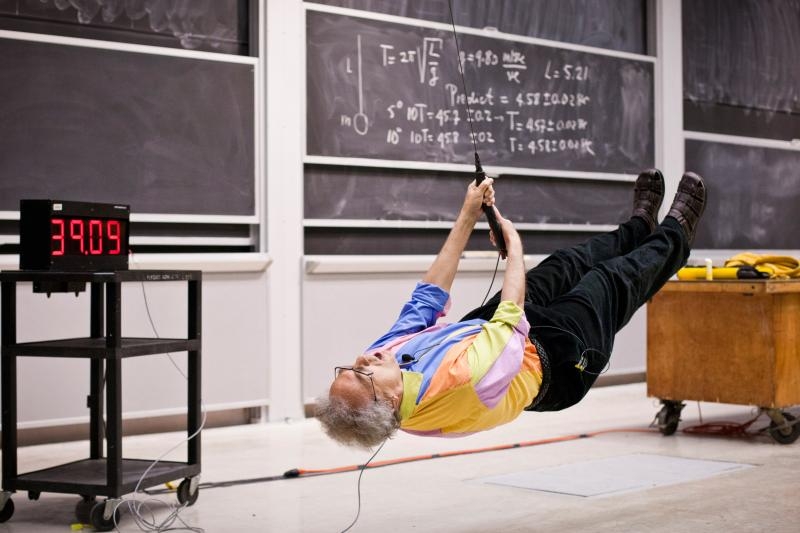Through the eyes of physics or autobiography through the lens of science

Walter Levin is an 80-year-old physicist and teacher at the Massachusetts Technical Institute. His lectures are accompanied by abundant gesticulation and non-standard actions, such as skating on a ball. Records of his courses gain millions of views on YouTube, and Bill Gates went through at least three of his programs. An intriguing introduction is enough for a popular science book written by a physicist. Is it really worth the attention of Walter Levin's book "Through the eyes of a physicist", or is it all just another marketing ploy? I spent the weekend to read the translation of his book and form an opinion about it.
The book reads easily, in the process of reading one wonders why it is impossible to teach physics in the same way in schools and universities. It all begins with a biography in which explanations of physical phenomena are woven, for example, the causes of blue sky and red sunset. After entering the university, Walter was able to kill three birds with one stone: cut himself off from the army, begin teaching at the school to pay off his study loan and, of course, get an education.
From the nucleus of an atom to open space
At the age of 29, Walter defended his doctoral dissertation on subatomic particles. For a dissertation, he worked with radioactive isotopes for several years and studied their decay. During this time, science has advanced significantly, and not only physics, but also astronomy, adored by Professor Levin. He compares physics with astronomy, saying that these are integral parts of each other.
In 1965, Professor Bruno Rossi from MTI invited Walter to work in the field of X-ray astronomy, founded only six years earlier. So Walter Levine from physics changed his profile in astrophysics, according to the author:
“Coming to MIT is the best thing that could have happened to me.”
Talking about Ross's work on the measurement of the solar wind, Professor Levin casually reveals the nature of the aurora.

Not the whole book is a fun biography with reasoning about physics. It has a place and tragedy.
When Walter was 4 years old, the Nazis came to The Hague. A part of his family was sent to the camps, and the grandfather and grandmother because of the inability to work, due to old age, to the gas chamber. The horrors of war, even after so many years, are haunting the author in nightmares.
Talking about the emergence of a new direction in astrophysics, Levin emphasizes that Professor Ross acted on a whim, rather than knowing what he was doing. So, together with the Nobel laureate Riccardo Jacconi, on June 18, 1962, Ross launched a rocket out of the atmosphere with three geiger counters. Thanks to this, X-ray radiation was discovered in space, and it also became clear that its source is located outside the solar system.
In 1967, one year after arriving at MIT and starting work with George Clarke, Walter received the reins of government for a research team working on X-ray search and research in space.
During the years when Walter began working at MIT, there were amazing discoveries and some of them were related to: the discovery of X-ray sources, the fundamental building blocks of the atomic nucleus, W and Z bosons, quarks and gluons and much more.
Thanks to physics and early discoveries, images were taken using the Hubble Space Telescope, showing the infinity of the galaxy to humanity. True, a little later than Walter began working at MIT in 2004.

Hubble Ultra Deep Field 2004
Physics has already explained a lot to us, and also answered many questions, allowing us to look into the smallest zones of the subatomic world, and into the farthest corners of the Universe.
Since the isotopes first fell apart in the hands of Walter Levin, he has not ceased to admire the discoveries and beauty of physics.
"For me, physics is an effective way to see the world, the great and the everyday, huge and momentary and how beautiful and closely everything is intertwined in it."
Over and over again, opening eyes to the beauty of the world and science, Professor Levin tries to teach his students physics in the same way - not letting him forget about the beauty of discoveries and not focusing on complex formulas.
The purpose of the book according to the author:
“Open your eyes to the wonderful ways in which physics opens the world, to show its amazing elegance and beauty”
Measurements, errors and stars
The chapter on the experimentalism of physics and that all, even the greatest discoveries in it are based on forecasts and their measurements, emphasizes the importance of taking into account errors in any calculations, even when purchasing clothes online. All evidence is simple and clear, they are taken from everyday life.
Using simple measurements, he proves that a person who is lying down is about 3 cm tall than a person who is standing, and this is explained by the effect of gravity.
And with the help of measurements of the femoral bones of different species of animals, Galileo Galilei’s theory is refuted, about why large animals are exactly of this size, and not larger.

Human femur
Walter also describes the method of parallax - the only possible way to measure the distance to the stars until the end of the XIX century. Over the course of time, the measurement methods slightly changed and the distances calculated earlier changed along with them. And this is a real scourge for astronomy - the impossibility of accurate measurements and the inclusion of errors in the calculations of cosmic mega distances. He also talks about the Cepheid method for measuring space distances, based on the luminosity ranges of stars.
When measuring the distance to the galaxy of Andromeda, our closest galaxy, using modern methods, the error between the results was approximately 140 thousand light years. What kind of error can we talk about when measuring the distance to more distant objects?
After this, the astronomers' race for standard candles becomes clear - objects with a known luminosity for accurate calculations. Today, an astronomical distance ladder has been formed, the first step of which is the measurement of distances using parallax. The second step of the ladder is measurements with the help of Cepheids, and at the next steps there are various technically complex exotic methods of measurement.
findings
H2O: ~ 30%
This is a really popular science book that explains complex mechanisms in simple terms. But it was not without its minuses of scientific literature - sometimes there are complex concepts unknown to people far from physics. Sometimes you have to re-read a paragraph again, because the words are understandable, and the values do not reach immediately.
I hope my short review will help you understand the value of the book and whether it is worth your time.
All good!
About the book:
“Through the eyes of a physicist. Journey from the edge of the rainbow to the border of time "Walter Levin and Warren Goldstein (Reference to the publisher)
Original:" For the Love of Physics. From The End Of The Rainbow To The Edge Of Time - A Journey Through The Wonders Of Physics by Walter Lewin and Warren Goldstein
